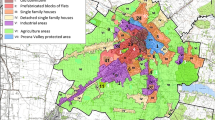Abstract
The temporal variation of the radon concentration, and the radon and thoron concentrations every 3 months for a year were measured using two types of devices in a landmark skyscraper, the Tokyo Metropolitan Government Daiichi Building. In the measurement of temporal variation of the radon concentration using a pulse type ionization chamber, the average radon concentration was 21 ± 13 Bq m−3 (2–68 Bq m−3). The measured indoor radon concentration had a strong relationship with the operation of the mechanical ventilation system and the activities of the office workers. The radon concentration also increased together with temperature. Other environmental parameters, such as air pressure and relative humidity, were not related to the radon concentration. In the long-term measurements using a passive radon and thoron discriminative monitor, no seasonal variation was observed. The annual average concentrations of radon and thoron were 16 ± 8 and 16 ± 7 Bq m−3, respectively. There was also no relationship between the two concentrations. The annual average effective dose for office workers in this skyscraper was estimated to be 0.08 mSv y−1 for 2000 working hours per year. When considering the indoor radon exposure received from their residential dwellings using the annual mean radon concentration indoors in Japan (15.5 Bq m−3), the annual average effective dose was estimated to be 0.37 mSv y−1. This value was 31 % of the worldwide average annual effective dose.






Similar content being viewed by others
References
WHO handbook on indoor radon (2009) The World Health Organization, France. http://www.nrsb.org/pdf/WHO%20Radon%20Handbook.pdf. Accessed 17 May 2013
Darby S, Hill D, Auvinen A, Barros-Dios JM, Baysson H, Bochicchio F, Deo H, Falk R, Forastiere F, Hakama M, Heid I, Kreienbrock L, Kreuzer M, Lagarde F, Makelainen I, Muirhead C, Oberaigner W, Pershagen G, Ruano-Ravina A, Ruosteenoja E, Rosario AS, Tirmarche M, Tomasek L, Whitley E, Wichmann HE, Doll R (2005) Radon in homes and risk of lung cancer: collaborative analysis of individual data from 13 European case-control studies. BMJ 330:223–226
UNSCEAR (2000) Sources and effects of ionizing radiation, Vol. 1. United Nations Scientific Committee on the Effects of Atomic Radiation, New York. http://www.unscear.org/docs/reports/annexb.pdf. Accessed 17 May 2013
Hosoda M, Sorimachi A, Yasuoka Y, Ishikawa T, Sahoo SK, Furukawa M, Hassan NM, Tokonami S, Uchida S (2009) Simultaneous measurements of radon and thoron exhalation rates and comparison with values calculated by UNSCEAR equation. J Radiat Res 50:333–343
Yu KN, Young EC, Stokes MJ, Tang KK (1998) Radon properties in offices. Health Phys 75:159–164
Doi M, Fujimoto K, Kobayashi S, Yonehara H (1994) Spatial distribution of thoron and radon concentrations in the indoor air of a traditional Japanese wooden house. Health Phys 66:43–49
Sanada T, Fujimoto K, Miyano K, Doi M, Tokonami S, Uesugi M, Takata Y (1999) Measurement of nationwide indoor Rn concentration in Japan. J Environ Radioact 45:129–137
Tokonami S, Pan J, Matsumoto M, Furukawa M, Fujimoto K, Fujitaka K, Kurosawa R (1996) Radon measurements in indoor workplaces. Radiat Prot Dosim 67:143–146
Annanmaki M, Oksanen E (1992) Radon in the Helsinki Metro. Radiat Prot Dosim 45:179–181
Espinosa G, Gammage RB (1995) Radon levels survey in the underground transport metro system in Mexico City. Radiat Prot Dosim 59:145–148
Song MH, Chang BU, Kim Y, Cho KW (2011) Radon exposure assessment for underground workers: a case of Seoul Subway Police officers in Korea. Radiat Prot Dosim 147:401–405
Tokonami S, Furukawa M, Shicchi Y, Sanada T, Yamada Y (2003) Characteristics of radon and its progeny concentrations in air-conditioned office buildings in Tokyo. Radiat Prot Dosim 106:71–76
Karunakara N, Somashekarappa HM, Rajashekara KM, Siddappa K (2005) Indoor and outdoor radon levels and their diurnal variations in the environs of southwest coast of India. In: Proceedings of the 6th International Conference on High Levels of Natural Radiation and Radon Areas 1276:341–343
Tokonami S (2010) Why is 220Rn (thoron) measurement important? Radiat Prot Dosim 141:335–339
Zhuo W, Tokonami S, Yonehara H, Yamada Y (2002) A simple passive monitor for integrating measurements of indoor thoron concentrations. Rev Sci Instrum 73:2877–2881
Sugino M, Tokonami S, Zhuo W (2005) Radon and thoron concentrations in offices and dwellings of the Gunma prefecture, Japan. J Radioanal Nucl Chem 266:205–209
Tokonami S, Yang M, Sanada T (2001) Contribution from thoron on the response of passive radon detectors. Health Phys 80:612–615
Iyogi T, Ueda S, Hisamatsu S, Kondo K, Sakurai N, Inaba J (2003) Radon concentration in indoor occupational environments in Aomori Prefecture, Japan. J Environ Radioact 67:91–108
Man CK, Yeung HS (1999) Modeling and measuring the indoor radon concentrations in high-rise buildings in Hong Kong. Appl Radiat Isot 50:1131–1135
Oikawa S, Kanno N, Sanada T, Abukawa J, Higuchi H (2006) A survey of indoor workplace radon concentration in Japan. J Environ Radioact 87:239–245
Acknowledgments
The authors thank Yuji Ikezawa, Hidemi Kamesawa, Kayoko Nakahama, Ayako Kobayashi, and Keisuke Tsuda, all of Tokyo Metropolitan University, for their field work. This work was supported by a strategic research fund from Tokyo Metropolitan University to Masahiro Fukushi.
Author information
Authors and Affiliations
Corresponding author
Rights and permissions
About this article
Cite this article
Inoue, K., Hosoda, M., Tokonami, S. et al. Investigation of radon and thoron concentrations in a landmark skyscraper in Tokyo. J Radioanal Nucl Chem 298, 2009–2015 (2013). https://doi.org/10.1007/s10967-013-2661-1
Received:
Published:
Issue Date:
DOI: https://doi.org/10.1007/s10967-013-2661-1




